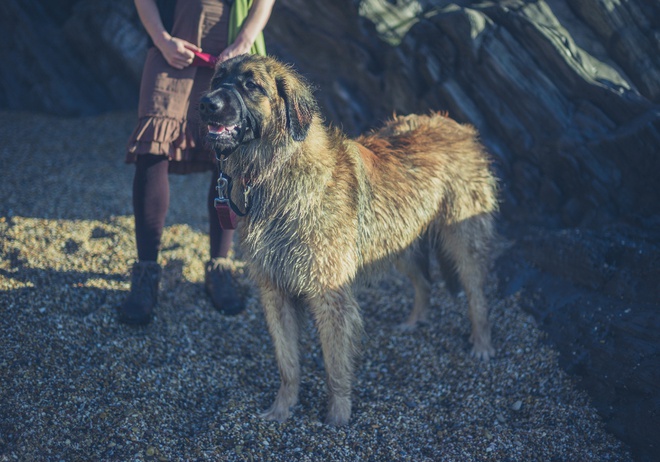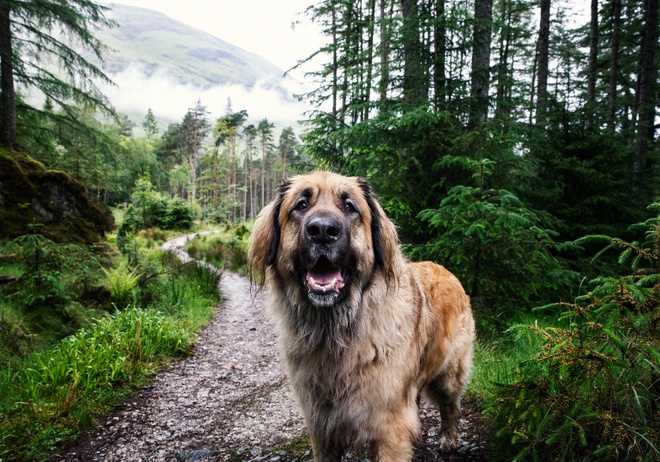The list of 9 largest dog breeds
Are you dreaming of becoming an owner of a big dog? If so, in this article you’ll find descriptions of the 9 biggest dog breeds as well as some tips on what you should think of before making a final decision.

Reading time : 6 min
TOPICS
Things to consider before getting a big dog

There is no doubt that with a big dog comes big responsibilities, so if you’re considering getting one of the big breeds, make sure that you’re ready for that. Be aware that a lot of the giant dogs were bred to be hard workers, and they still maintain instincts and drives that in the past made them better suitable for their job. For that reason, they may sometimes be difficult to handle by inexperienced dog owners.
Costs
The maintenance of big dog breeds can be expensive, as food, toys, and other supplies cost more or are needed in bigger quantities. Apart from that, like all other pets, big dogs require regular vet visits, which can be more expensive than in the case of smaller dogs. It might also be harder to find a pet clinic with the equipment and space big enough to treat a giant dog. In this case, you might have to add additional travel costs to the expenses for the health care of your pet.
Space
It might seem obvious, but it’s important to remember that big dogs take much more space than smaller breeds. And it’s not only the dog that’s bigger, but also the toys they play with, the bed they sleep in, and the bowls they eat from. For this reason, when you decide to adopt a giant dog, make sure that there’s enough space in your house for them to move around easily and to have their own place. Moreover, if you travel a lot, you might encounter some problems. If you decide to take your dog with you, some hotels, restaurants, or cafes might not be big-dog-friendly. On the other hand, if you leave your dog at home, finding a qualified dog sitter or walker for a big dog can be difficult.
Training
Even though all dogs need training, no matter their size, it is even more necessary for the big dogs. Because of their size, all the behaviours, even those that are harmless and seem cute when done by the small breeds, might be dangerous or simply tiring for an owner of a big dog. It’s important to start the training sessions with your dog very early, when they are still young puppies, also because that will give you a bit of control over your not-yet-giant dog. Remember to keep the training sessions positive and fun, and don’t hesitate to reach out to professional trainers for help and guidance.
Which dog breed is right for you?
Take the test and find out the dog breed that matches your personality and lifestyle.
The list of 9 biggest dog breeds

Great Dane
A widely recognised breed developed as a cross between the English Mastiff and the Irish Wolfhound, it is also known to be the largest dog breed in terms of height, according to the American Kennel Club. The adult dogs reach the weight of 100-120 pounds, and their average height is 30-34 inches. The biggest dog in the world was a Great Dane named Zeus, who reached an astonishing height of 44 inches. Zeus passed away in 2014 at the age of 5, but he remains the holder of the record to this day.
Great Dane dogs are thought to be originally bred by German nobles for hunting big game and protecting properties. Nowadays, they are friendly and outgoing companions, who make excellent family dogs. They still retain their loyalty and alertness to keep their home safe.
Anatolian Shepherd
The American Shepherd is believed to be an ancient Turkish breed, dating back to 2000 BC, and developed to guard livestock and properties. These dogs usually reach the height of 32 inches and a weight of around 150 pounds, and what stands them out from other giant breeds is their long lifespan, 13-15 years on average. Their protective instincts and territoriality, along with smart and loyal nature make them popular as ranch dogs nowadays.
Dogue de Bordeaux
Also called a French Mastiff, the Dogue of Bordeaux is another breed considered to have ancient roots. Throughout the centuries, the dog has had many different roles – from hunting big games in the 12th century to guarding livestock to pulling carts, and the list continues! This breed measures around 24-26 inches in height and around 100 pounds in weight, and it’s known to have the proportionately largest head of all the breeds. What stands the Dogue de Bordeaux out is also their expressive and wrinkled face, which is also a reason why the dogs from this breed are prone to suffer from dermatitis. This breed is sensitive and loyal and seems to have two natures: an energetic one when they’re outside, and mellow and soft when inside.
Irish Wolfhound
As the name suggests, this breed was originally developed to hunt wolves, but the dogs were also used in wars, and later as guards and hunters of other animals. They are thought to be brought to Ireland around 7000 BC. The Irish Wolfhound is the tallest breed, taller even than the Great Dane and reaching around 34-35 inches on average. Personality-wise, they are intelligent, easy-going, and even rather reserved. They get along very well with children and other pets, but they’re most suitable for active families as they need a lot of exercise on daily basis.
Leonberger
A cross between a Saint Bernard, a Newfoundland and a Pyrenean Mountain Dog, the Leonberger resembles a huge, 30-inch tall, ball of fluff. Primarily bred as a company dog for European royalty, this dog makes a great watchdog, but can also be relied on in executing other tasks. Nowadays, Leonbergers are often used on the farms, as they do an exceptionally good job at cart pulling and draft work.
Leonbergers should be trained from the very early age and are generally recommended for experienced dog owners. Once socialised and properly trained, they can be amazing family dogs, with great sensitivity that makes them good even for very young kids.
English Mastiff
Known to descend from ancient war dogs and in the past participating in blood sports, English Mastiffs are among the heaviest dog breeds. In fact, the record for the largest dog was once set by an English Mastiff named Aicama Zorba, who weighed 343 pounds. Nowadays, the breed seems to have completely forgotten about its courageous past, as English Mastiffs are considered gentle giants. They are loyal and easy-going, which makes them both loving and lovable family members. If not lying comfortably on the sofas, English Mastiffs perform police, military, and security works, where their high intelligence comes in handy.
Neapolitan Mastiff
The origins of the Neapolitan Mastiff can be traced back to ancient Rome, but the dog is known to be bred in the southern Italy, where they were used to guard properties. Their peculiar and characteristic wrinkles and skin folds are to protect Neapolitan Mastiffs in case of an attack. The average height of this breed is between 26-31 inches, and they weigh around 150 pounds. Mastiffs are amazing guard dogs due to their protective and fearless nature, but instead of barking, they tend to silently sneak up on intruders. This protective nature can come in handy, but it also means that the breed should be properly trained and socialised in order to avoid any unpleasant incidents.
Newfoundland
Originally bred as a helper for fishermen in Canada by pulling the nets out of the water and performing water rescues, the Newfoundland dogs are up to this day working as lifeguards. They are even naturally predisposed to swimming in the water, thanks to their webbed feet and water-repellent coat. These dogs, reaching around 27-29 inches in height, are exceptionally intelligent, which makes them highly trainable. They are also very lovable and gentle, and their big fluffy coat makes them perfect to cuddle with.
Saint Bernard
Saint Bernard is one of the most recognisable giant breeds, to which contributes the breed’s popularity in film and TV. They were first bred in the Swiss Alps by a monastery that used the dogs to guard the land, hence the “religious” name. Quickly it was discovered that Saint Bernards are not only great in protection, but that they are predisposed to be search and rescue dogs – the task that they are used for up to this day. Their charming temperament and friendly expression make them highly lovable. Apart from that, thanks to their gentle nature, they are amazing family dogs that get on perfectly with children and other pets.
Conclusion
Owning one of the big dog breeds can be a big responsibility and can cause some inconveniences, which is why you need to be fully convinced that you’re ready for that step and you really want it. As this article proves, your dedication will not be lost on nothing, as large dogs can be great companions and amazing family dogs that will give you lots of love and devotion.
Continue reading our guide
This article is a part of a complete guide on the subject. Do not miss the next chapters.
Which dog breed is right for you?
Take the test to find out!
Choosing a dog that matches your personality and lifestyle will ensure your well-being and his!
